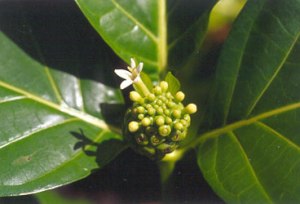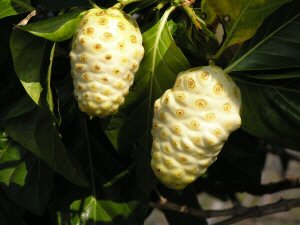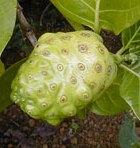Classification
 Domain: Eukarya
Domain: Eukarya
Kingdom: Planteae
Phylum: Magnoliophyta
Class: Magnoliopsida (dicot)
Order: Rubiales
Family: Rubiaceae (coffee family)
Genus:
Morinda
Species:
Morinda citrifolia
Eukarya: Morinda citrifolia is a eukaryote with organelles and a nucleus. This organism is also multicellular with linear chromosomes and has male and female parts on each plant, meaning it can reproduce sexually. Eukarya also have 80s ribosomes.
Plantae: Noni are autotrophs that photosynthesize, and have chloroplasts. These organism also have the ability to prevent water loss with structures called guard cells and obtain carbon dioxide and release oxygen with openings called stomata. Noni usually have alternation of generations, meaning they have multicellular haploid and diploid stages. This plant also posses a cell wall made of cellulose, unlike fungi and bacteria that usually have cell walls made of chitin.
Magnoliophyta: Noni have a true flower and is pollinated by various animals, such as bees, or can self-pollinate. This organism produces fruits that bear the seeds of the plant and can bee eaten by animals, including birds, mice, and cattle. Noni also have the ability to double fertilize and produce endosperm.
 Magnoliopsida:
This is the dicotyledonous class of angiosperms.
Nonis have the ability for secondary growth due to
the rings of xylem and phloem and have an area
between the xylem and phloem called the vascular
cambium. Noni leaves have branched veins and have
flower petals in multiples of 4 or 5.
Magnoliopsida:
This is the dicotyledonous class of angiosperms.
Nonis have the ability for secondary growth due to
the rings of xylem and phloem and have an area
between the xylem and phloem called the vascular
cambium. Noni leaves have branched veins and have
flower petals in multiples of 4 or 5.
Rubiales: Rubiales are characterize by having an inferior compound ovary. Coffee plants are apart of this order.
Rubiaceae: Ruciaceae usually
live in very humid tropical areas and is widespread,
but rarely found in aquatic environments.
 It consists
of mostly small trees and shrubs that are found
annually. Plants in this family can have bisexual or
unisexual flowers. These plants usually lack an
internal phloem and have simple leaves that can be
opposite or appeared whorled. This family also is a heterostyly,
or “different styles”, meaning it has a
couple different lengths of mature flowers; in fact,
this family has more species with dimorphic heterostyly, or two
different lengths of flowers, than any other
angiosperm family. This thought to be a safeguard
for cross-pollination because it’s most likely to
have pollination of a longer flower from a shorter
one, and vice versa, than to have two of the same
type of flower being pollinated.
It consists
of mostly small trees and shrubs that are found
annually. Plants in this family can have bisexual or
unisexual flowers. These plants usually lack an
internal phloem and have simple leaves that can be
opposite or appeared whorled. This family also is a heterostyly,
or “different styles”, meaning it has a
couple different lengths of mature flowers; in fact,
this family has more species with dimorphic heterostyly, or two
different lengths of flowers, than any other
angiosperm family. This thought to be a safeguard
for cross-pollination because it’s most likely to
have pollination of a longer flower from a shorter
one, and vice versa, than to have two of the same
type of flower being pollinated.
Morinda: There are
about 80 species within this genus. The Morinda
genus includes trees, shrubs, and vines and there
are a few species that exhibit "vine-like"
characteristics, such as Morinda citrifolia.
 One thing that all the species in this genus have is syncarps or capitula (aggregated fruits) which can
be fleshy or dry.
One thing that all the species in this genus have is syncarps or capitula (aggregated fruits) which can
be fleshy or dry.
Morinda citrifolia: The Noni’s scientific name, Morinda citrifolia, tells you something about the species. The genus name Morinda is derived from the word morus meaning mulberry, and indicus meaning Indian; this name is indicating that the plants fruit is similar to a true mulberry. The species name citrifolia indicates that the plant’s foliage is similar to that of a citrus species, such as oranges. Though mostly referred to as the Noni, Morinda citrifolia has an abundance of common names in a lot of different languages. This is just a small list of them.
 Canary wood - Australia
Canary wood - Australia
Cheesefruit - Australia
Indian Mulberry - English
Lada - Guam
Kura - Fiji
Mora de la India - Spanish
Noni - Hawaii
Nono - Tahiti
Mangal’wag - Yap
Doleur - Haiti
Wild pine - Barbados
Yor ban - Thailand


Return to Home
Check out the Habitat and Adaptation page Next
